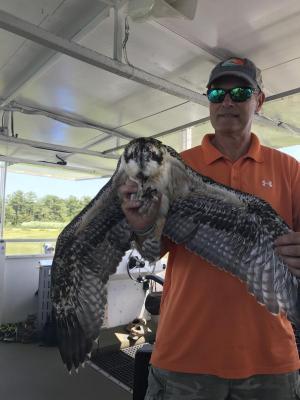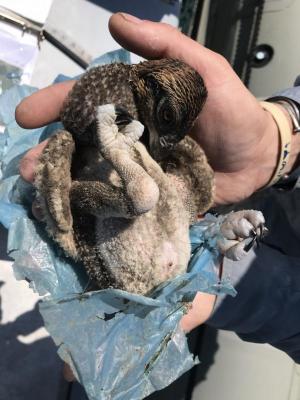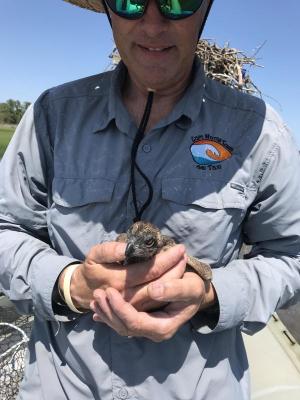Banding of the osprey
Recently, I watched Captain Steve put a ladder up to an osprey's nest. With one swift hand, he plucked a bewildered fledging into the air while we watched out the windows of the water taxi.
In the summer months, this is retired teacher Steve Cardano's job – to educate the public about the well-being of our feathered friend, the osprey. Steve says, "I have been a bird bander for years, and I love teaching people about ospreys and their habits."
Captain Steve held up a plastic bag and fishing rope which he quickly removed from the nest. Plastics floating in the water are a huge problem for all of our wildlife. In the past, he has removed plastic bags from around the swollen feet of osprey and saved a bird's life.
Osprey are making a comeback in Delaware, and the number of mates is on the increase, which is a sign of a healthy wildlife environment. Their biggest predators are great horned owls that steal the eggs.
As the mother circled the boat, the baby was paraded down the aisle by Cape Water Taxi owner Captain Dave Green so passengers could get a closer look. Within minutes, the bird was returned to its nest where it will learn to fly in a few weeks.
Cardano revealed that ospreys migrate as far away south as Colombia, Venezuela or the Brazilian rainforest. The adults usually come back to our area after about two years to the same nest. Steve called it "nest site fidelity."
I love that phrase, "nest site fidelity."
Isn't that a human characteristic, to look forward to nesting back in our own beds after traveling to other places for a few weeks?
Ospreys can live as long as 24 years and produce three eggs each year. Cardano says there is no way to measure their average life span, but in the first year, scientists believe, they lose 50 percent or more of the adults.
They don't take early retirement. Instead, adult males return to Delaware and show off their fishing skills, hoping to attract a new mate.
Osprey eat mostly menhaden. You can't live in Lewes and not know that fish name, which helped to literally establish our first town. When menhaden were plentiful, Lewes prospered.
Have you noticed the contraption down by the Lightship Overfalls and the baseball fields in Lewes? This wheel-like structure was used to clean and dry the nets used to harvest the fish. Menhaden are still processed into fishing oil and fish meal for animal feed and dietary supplements.
Delaware State Parks employee Kathleen LaForce, who helped with the banding, described her feelings: "Wildlife is my passion, and it's great to get the community involved."
Captain Dave showed the bird up and down the aisle. It didn't look at all like a fledgling, as it seemed enormous. We could see the metal band on the osprey's ankle where an 800 number and a website are listed to encourage people to help track the birds so we can learn more about them.
If you want to see an osprey banded, there are plenty of opportunities available this summer, all at 10:30 a.m. on the Lewes dock near Irish Eyes. Check out www.capewatertaxi.com for their schedule of osprey banding tours and many others.
Enjoy bird watching!






















































